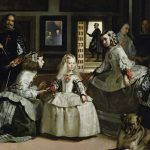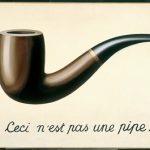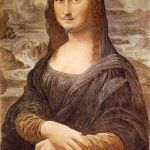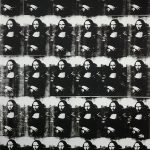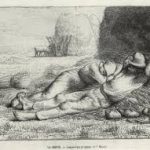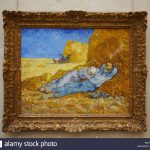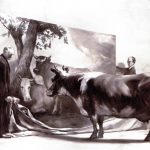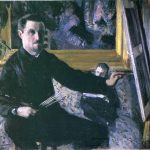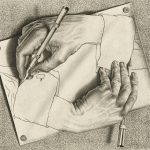“The famous pipe. How people reproached me for it! And yet, could you stuff my pipe? No, it’s just a representation, is it not? So if I had written on my picture ‘This is a pipe’, I’d have been lying!”
— René Magritte
REPRESENTATION
The study material now conclude that by having established the fundamental and all important distinction between constructivism and realism we should have a context in which to unpack the meanings of ‘representation’ and ‘sign’. I need to understand this from the “contentions realm of postmodern theory” – ( study material p 73). In this part of the learning blog I will answer and discuss 6 exercises.
Schopenhauer says, ” Not merely philosophy but also the fine arts work at bottom towards the solution of the problem of existence. For in every mind which once gives itself up to the purely objective contemplation of the world, a desire had been awakened, however concealed and unconscious, to comprehend the true nature of things, of life, and of existence.” (2010,97)
Representation assumes that there is something real that you represent. So there is the subject and the thing, and in between you have the representation. In the traditional way of thinking images is second order reality: there is the real and the image is the copy of the real. I think this is what we would call the ‘common sense view of representation’ as referred to in the study material on page 73. Abstract Art rejected the idea of finding resemblance. The term non-representational is frequently used as a synonym for abstract. Reference or resemblance in for example portrait painting, will start with a sitter which the artist, by painting the sitter intent/purpose to make the painting (the representation) look like the sitter, so the portrait/representation carries with it the artist’s intention to represent. This also implies that this representation/portrait is not the source of meaning. Meaning will only come once there is agreement between viewers and the work. The sitter was present at a location and time and was represented in the painting. The interesting part is when another artist makes a copy of this painting. How will this affect the relation between the copy and thie model?
On the TATE website I find the following explanation for Representation: ” Blanket term for art that represents some aspect of reality, in a more or less straightforward way. The term seems to have come into use after the rise of modern art and particularly abstract art as a means of referring to art not substantially touched by modern developments.’
I read the following: “Thus the prevalence of postmodernism today, if indeed it prevails,
does not suggest that ideas of institutions of the past cease to shape the present. Rather, traditions develop, and even types suffer a sea change. Certainly, the powerful cultural assumptions generated by, say, Darwin, Marx, Baudelaire, Nietzsche, Cezanne, Debussy, Freud, and Einstein still pervade the Western mind. Certainly those assumptions have been reconceived, not once but many times—else history would repeat itself, forever the same. In this perspective postmodernism may appear as a significant revision, if not an original èpistemé, of twentieth century Western societies.” (Ihab Hassan, “Toward a Concept of Postmodernism”, The Postmodern Turn, 1987) and then I quote Bergson’s opinion from a MA Thesis “Matter, in our view, is an aggregate of images. And by image we mean a certain existence which is more than what the idealist calls a representation, but less than that which the realist calls a thing, an existence placed halfway between the thing and the representation”. (bilkent.edu.tr/0002533.pdf)
Being an image, whether a realistic painting a sculpture, film, mental picture, thought or metaphor, lies in its position of being “placed halfway between the thing and the representation”, so an image can never be a total thing in itself and also cannot be the thing it mimes to be.
I am reminded that in the pre Modernist period, the philosophical focus was on the concept of “being,” that is, on human existence and the relationship of “being” to God and the Universe. In the modernist period, the focus shifted from being to knowing/ consciousness, or from existence to cognition. In this period, the main concern was to understand the individual as a cognitive subject and to view the external world as a rational social order. In the postmodernist period, it seems there is an even further shift from a rational to a symbolic system, “a semiotic world of postmodernism, with symbol and sign.” Here the unconscious are manipulated or influenced (Venkatesh) I am also aware that our connection between reality and how we respond to it, is very much on the indirect and inferred. I agree with Lippmann who observed that the world we try to apprehend is invariable out of reach, out of sight, out of mind. He states: ” For the real environment is altogether too big, too complex and too fleeting for direct acquaintance. We are not equipped to deal with so much subtlety, so much variety so many permutations and combinations. And although we have to act in that environment, we have to reconstruct it on a simpler model before we can manage with it.” (1922, 12 ) We have to explore and imagine our reality, in order to have any picture of it at all. I am also inclined to think that we as humans struggle to be authentic, and art taps in on this humane part of our existence.
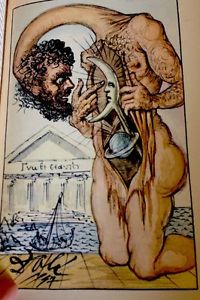
I have by now decided to understand the Sophistic and Socratic art discourse – in short I see the different branches and divisions which allow us to see the object from different branches. Representation refers to ‘mimetic’ in Greek. The earliest theory of art, that of the Greek philosophers, proposed that art was mimesis, imitation of reality. I looked at the sophist as a appearance maker within productive art, where the painter came into discussion and being seen as that he can fool the inexperienced person into believing the painting to be the thing it is portraying – thus fool him/her into believing that what is asserted , as the truth. Imitation art is divided into likeness making and appearance making. In the end Plato brings us to understand that Sophistry is concerned with Logos (discourse) and in Plato’s dialectic method it ascend from appearance to essence and from opinions/beliefs to knowledge. Plato was aware, had a dilemma, according to Coda ( 2009, 505) that art had the power to undermine and destabilise, not only political structures, but religion – causing ordinary citizens to literally think otherwise than what they are legally compelled to believe.
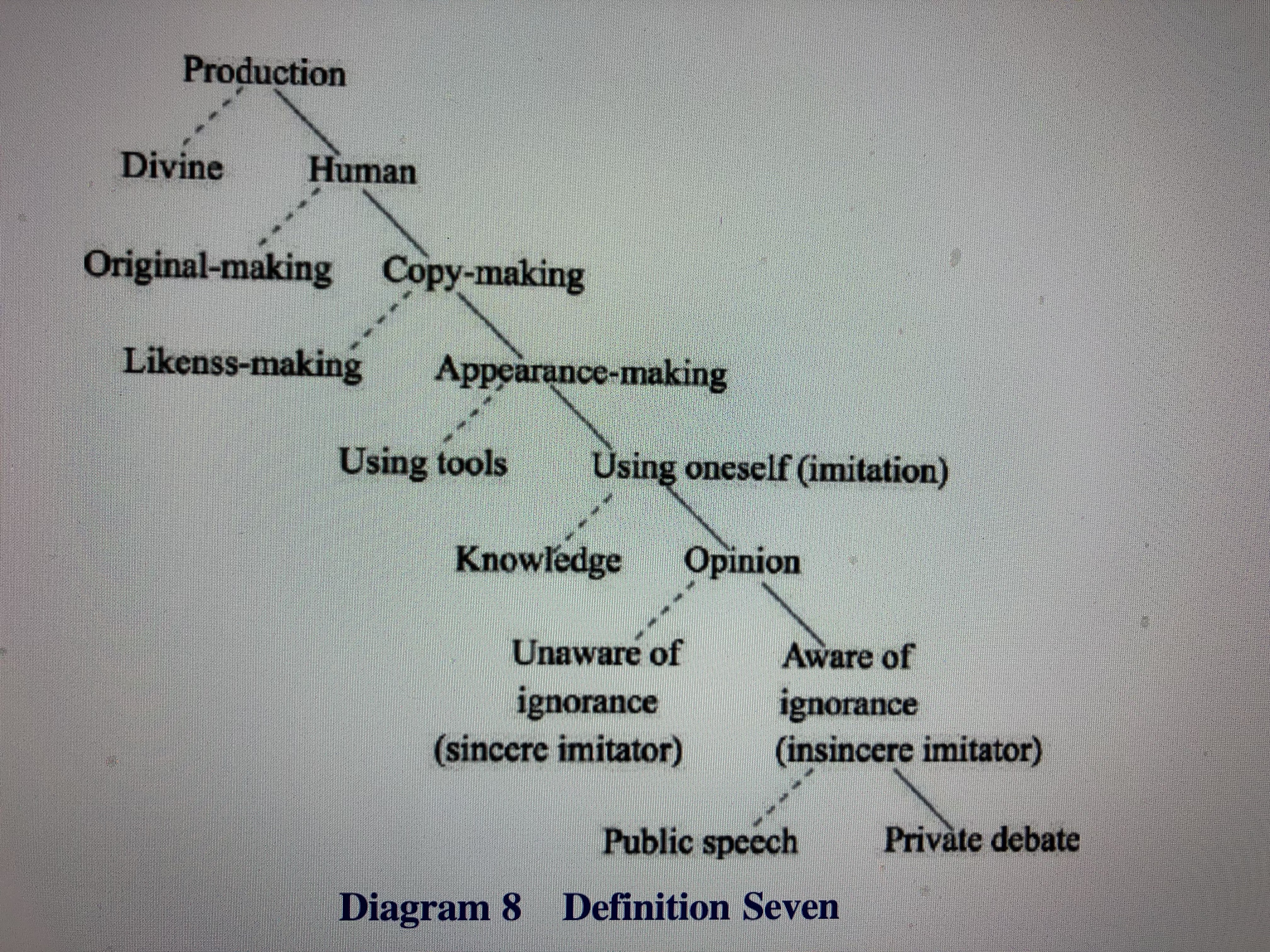
I think what I take away from Plato’s invocation is not simply a concern for representing the actual world/reality, but art’s ability to “fabricate the actual world in which we really do live.” (2009,504) ( refer to discussion in question 3.2) Danto says the following: “Plato knew what Picasso was to discover in an artistic tradition that had not been corrupted by philosophy, that art was a tool of power” (2014, 113) Is it that Picasso could distinguish art from reality with cubism?
Exercise 3.2
Do you think art is and will remain a distinct category or is it best seen as a species of visual culture?
I made the following assumptions after reading about definitions for art:
- Fine art as a distinct category in European academic traditions developed primarily for aesthetics or beauty, distinguishing it from applied art, which also has to serve some practical function, such as pottery or most metalwork.
- Historically, the five main fine arts were painting, sculpture, architecture, music, and poetry, with performing arts including theatre and dance.
- The theory of art integration in education was explored as early as the 4th century B.C. in ancient Greece where Plato stated that art forms should be used as foundation of educational method.
- From the founding of the first art academy in Florence in 1563 up to the twentieth century, ‘art’ has been understood primarily in terms of the three so-called arts of design: painting, sculpture and architecture, all of which were considered to demand talent and intellectual application as well as the acquisition of manual skill. Medieval art and Renaissance art present a challenge to this definition.
- Today, the fine arts commonly include additional forms, such as film, photography, video production/editing, design, sequential art, conceptual art, and printmaking
- While the definition of art has changed over the years, the field of art history has developed to allow us to categorise changes in art over time and to better understand how art shapes and is shaped by the creative impulses of artists.
- Having a solid grasp of art history, then, is important to contextualise it.
- Art is linked to aesthetics, a branch of philosophy.
Aristotle saw representation as a definitively human activity because man has an instinct for representation, and in this respect man differs from the other animals that he is far more imitative and learns his first lessons though imitating things. The means of literary representation is language. An important part of representation is the relationship between what the material and what it represents. Aristotle discusses representation in three ways—
The object: The symbol being represented.
Manner: The way the symbol is represented.
Means: The material that is used to represent it.
In the 21st century visual culture has grown as a recognized interdisciplinary field of study, taking a multi-faceted approach to understanding how images of all types communicate and participate in the construction of identity, gender, class, power relationships, and other social and political meanings and values. Medicine, science, politics, consumer culture, and religion and spirituality are some of the arenas that visual culture studies examine along with art. Just as visual culture scholars are examining images and media of all types so, too, are 21st-century artists drawing inspiration, imagery, materials, and concepts from diverse areas of culture, moving well beyond influences from the history of fine art and design.
I found the following on the OCA website: “This unit is an introduction to a complex field of study. It takes you through the core theories that underpin a contemporary understanding of visual culture, looking at theories about how we look at the world and understand the visual vocabulary that describes it. The unit focuses on the practical application of those theories and will provide a sound introduction to the subject in an interdisciplinary fashion. The unit looks at the ideas in Structuralism, Post-Structuralism and Post Modernism. You will be introduced and guided to a clear understanding of the key texts in the study of visual culture. You will be required to research a variety of subjects and will therefore need access to the Internet as a research resource.”
Leonardo da Vinci advised the budding artist with creative block to leave behind his blank canvas and stare at the stains on walls: ‘If you look upon an old wall covered with dirt, or the odd appearance of some streaked stones, you may discover several things like landscapes, battles, clouds, uncommon attitudes, humorous faces, draperies, etc. Out of this confused mass of objects, the mind will be furnished with an abundance of designs and subjects perfectly new.’ Leonardo’s technique, which encouraged the viewer to search for meaning in nature/chaos, referred back to myths about the origin of art in accidental shapes. Throughout history the blot has been the rawest and most blatant expression of artistic debates about interpretation. On the Tate website I read the following: “If all art is, in one way or another, ‘seeing things’, and if all art criticism is interpretation – or, as Susan Sontag says, against it – then blots and stains and graphic accidents are, as Alberti suggested, the basis of all art. The meaningless stain, which invites the universal urge to project meaning, is the humble stage on which all arguments about art are rehearsed.” I am at this point with the following line of thought: During modernism art became a statement of the artist and (or is it but?) the content of art is challenged in the following way:
to view/interact in a space which could be a gallery/museum/online/book
to critique/reconstruct and to compare with knowledge/theories/rules
to interpret/ give meaning to and
to consider as value (aesthetic and monetary)
Armstrong and de Botton (2015: 4) argues that since the “beginning of the twentieth century, our relationship with art has been weakened by a profound institutional reluctance to address the question of what art is for”. They refer to our encounters with art in museums or exhibitions which make us feel inadequate, underwhelmed, or even bewildered and to assume that the problem must come down to us seeing ourselves to be blamed, because we have a lack of knowledge or capacity for feeling. An interesting Netflix production, left me with a depressed feeling, when a comment was made about whenever art is discussed in mainstream news media, it is always linked with the Price paid. Art became/ is represented as a commodity and through agreement the art market, developed since the sixties
List reasons for and against a distinct category
Art traditionally place more influence on historical importance and too little understanding of the culture and social history. I agree with Coda (2009,506-507) where he says that ” in a very real sense, art history has evolved precisely as an ambivalent set of positions taken on signification and representation, and remains trapped by the dilemma addressed by Plato 2500 years ago.” Plato’s dilemma was how to maintain the Ideas of Truths powerful against art which, if understood literally, can be interpreted as truths, and thus influence thoughts of ordinary citizens otherwise than what they are legally compelled to believe. This is a reality history has been playing out within religion, social and political and aesthetic positions. Susan Sontag (1979,49-51) refers to painting as being “handicapped from the start by being a fine art, with each object a unique, handmade original” – then she elaborates on the Surrealist movement and how theater, arts of assemblage and photography started ‘interfering with realism’ – creating a ‘duplicate world, of a reality in the second degree’
Then we have also seen the other side, where many critics decried the rise of artwork in the 1960s as a sign that the purity of art was lost. Clement Greenberg could be seen as preoccupied with the notion of art for art’s sake and was most vehement in his denunciation. He applied the German word kitsch to what he saw as art tainted by consumerism – I can apply this to my understanding of the work of artist, Jeff Koons and the Art Market which is very much consumed by the power of money – almost not about the art itself. I refer to a video is saw: Blurred LIne: Inside the Art World, 2017 by Barry Avrichs and presented at the Tribecca Film Festival in April 2017. Here the art world is referred to as a religion, a belief system.
Art as a separate category can be seen as elitist and ‘high culture’ and well as too institutionalised – all the issues that the modernist came to deconstruct. I also think that in learning from the long history of Art that artist had for many years had to make art that was expected of them.
Visual Culture shift in focus away from aesthetic beauty to the underlying concept of the work (conceptual art and performance art are good examples). According to Danto (2014,46 )the question “what is art?” emerged around 1964 and “once it was determined that a philosophical definition of art entails no stylistic imperative whatever, so that anything can be a work of art, we enter what I am terming the post-historical period.” Danto attributes ideas of Gombrich when he writes: “As I see it, the history of art was pretty much governed by perceptual truth, which did not change form one end of the period to the other, though the art of making clearly did.” The grounds is the mismatch with visual reality, as he felt the artist begins with and idea, his idea of concept, and not with a visual impression. “Making comes before matching in pictorial representation as theory comes before observation in scientific representation” was Combrich’s assumption, which he again took from a scientist, Popper, who wrote about science that have to reject theories when falsified by newer theories. (2014,50)
I think it apt to look at Art Critique, Greenberg and his opinion about experiencing art and towards people who do not make the effort to experience or appreciate abstract art, during the early 1960’s and when Danto (2014, 87) sees this as an aesthetic and value judgement by Kantian rules towards art, as only abstract art was good art accordingly. Danto sees that Greenberg also argued that “modernist art made it easier for art viewers to appreciate traditional art or art from other cultures, since representational art distracts us into thinking about what it shows rather than about what it is” ( 1997, 93). This touches very much on having an opinion about a culture, without understanding or appreciating as it is appreciated from within. Visual culture is very much involved in opening up this opinions and judgements. We need critique based on Hegel’s’ intellectual judgment of ” (i) the content of art, and (ii) the work of art’s means of presentation.” (2014, 98) Danto calls “criticism needs nothing further. It needs to identify both meaning and mode of presentations, or what I term ’embodiment’ on the thesis that artworks are embodied meanings. …putting all that into words is what art criticism is. To its credit, Kantian art criticism was able to dispense with narratives”
I think visual culture is commentary and expression of society on a personal and the universal level, but in a more visceral way. I love how meditation practices, volunteer and activist work can for example be presented and how it pushes the art techniques and work that can really create discussion about the work as well as environmental issues. Visual culture scholars analyse film, television, graphic novels, fashion design, and other forms of popular culture in addition to established fine art media such as painting, and they draw upon many methodologies and theories, including semiotics, sociology, psychoanalysis, reception theory, feminism, and the concept of the gaze, to name a few. When we want or need see art, we go to a gallery/museum and stand in front of it, yet we do not get to interact with it – like touch it, or always see it in the original setting, light conditions is altered. Art will however always challenge the viewer and we should therefore not expect to always understand art.
How many ways could ‘best seen as’ be understood? Aesthetically, morally, socially
The purpose and nature of art has shifted into a different course with the invention of photography. In the period pre the nineteenth century art was often commissioned and commissioned to depict a particular subject for a particular purpose, be that to record an historical event, or to inspire religious devotion, of the honor a famous individual. A Making images in art is also used to communicate ideas about aesthetics, morality and society, but meaning is given by the viewer. Because artistic conventions are different across periods, cultures, and human development, the appreciation of art will necessarily vary from one person to the next. Art symbolizes, alludes to human nature in the discourse to our search for making sense of our reality, our self-understanding, self-acceptance and fulfilment and happiness – to benefit society. We also ask how effective is art museums/institutions in our lives – do they see themselves as the ‘main event’? Do they still believe in what they are doing? How do they affect our lives? Art criticism in the traditional period was based on visual truth.
The move from art as mimesis to expression during the modernism period, brought with it a collective self-questioning of art as an own subject. Greenberg used the ‘essence of art’ – namely to be true to it, and find its own philosophical essence. He found this in, as Danto refers to it, “material conditions of the medium…..It came to an end with pop…. when art, as it were, recognized that there was no special way a work of art had to be” (2014,125) I find value in getting to foundational questions about the nature and function of art with relation to our daily living. It is important that theory and criticism relate to art practice. Contemporary art practices get to the point where it critically investigate the creative core of an art production, and hereby stimulate dialogue and debate, a cross creative disciplines. As postmodern people look and contemplate art, we also – on the other hand have people just taking pictures – beholding, spending time with art? Not seeing everything as potential valuable – it takes time. How did the culture of internet/digital browsing influence our view of using or engaging with actual spaces. We can look at museums as places where works of the highest value are shown in the ideal space – size of the room and or getting to moving maximum people through it in order to be a viable business.
If I reflect on the short experience I have had with formal art studies, I am very aware of the influence of looking at my artistic practice almost as a type of research – questioning, contextualising and articulating experiences whilst in the ongoing process of making art. Deleuze (2015,77-84) discus paradox and refers to Alice in Wonderland: “Which way, which way? ” asks Alice. The question has no answer, since it is the characteristic of sense not to have any direction or good sense.”
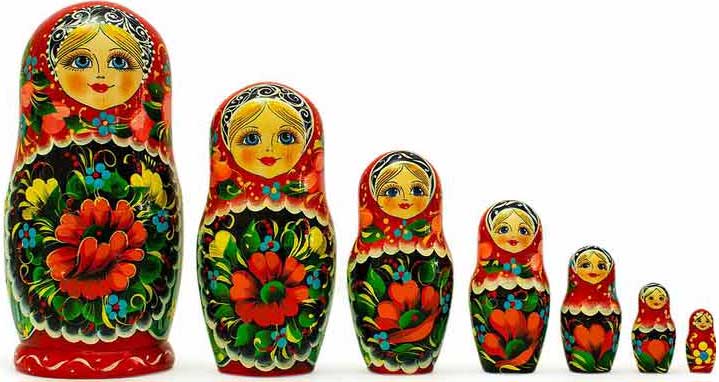
“Everything we see hides another thing, we always want to see what is hidden by what we see.”

Armstrong John & de Botton Alain, Art as Therapy 2015, Phaidon Press Limited, London
Burkeman, Oliver, 2015, The Guardian: Why can’t the world’s greatest minds solve the mystery of sonsciousness? Online article read on 18 February 2019.
Dante Arthur C, 2014, After the end of Art, Princeton University Press, Princeton and Oxford
Lippmann Walter, 1922 Public Opinion, KIndle edition
Coda, 2009, Plato’s Dilemma and the Tasks of the Art Historian Today, in Donald Preziosi, The Art of History, Second Edition, Oxford University Press, Oxford.
Schopenhauer Arthur, 2010, The Essential Schopenhauer: Key selections from the World as Will and Representations and other writings, edited by Wolfgang Schirmacher, HarperCollins Publishers, New York.
Sontag Susan , 2001. The Conscience of Words; Why the Wisdom of Literature Lies
in the Demonstration of the Multiple Nature of Our Private and Communal Destinies
Sontag, Susan, Against Interpretation
Venkatesh, Alladi 1992. Postmodernism, Consumer Culture and the Society of the Spectacle”, in NA – Advances in Consumer Research Volume 19, eds. John F. Sherry, Jr. and Brian Sternthal, Provo, UT : Pages: 199-202.
Wei, Liu, 2013, Plato’s attempts at defining Sophistry – Online publication accessed on 17 February 2019.
Greenberg, ‘Avant-Garde and Kitsch, quote by Arthur C Dante, 2014, After the end of art.
Smithsonian website Read more: https://www.smithsonianmag.com/arts-culture/art-for-the-masses-180940993/#8orzPCgp1rhTfiiu.99
Exercise 3.3 Meta painting examples from the 17th century to the present
Reading and understanding of The meta-picture and the ‘meaning’ of ‘original’. Meta is a prefix and has come to be understood primarily in terms of self- reflection. The Online Etymology Dictionary describes it as follows: “Meta- word-forming element of Greek origin meaning 1. “after, behind; among, between,” 2. “changed, altered,” 3. “higher, beyond;” from Greek meta (prep.) “in the midst of; in common with; by means of; between; in pursuit or quest of; after, next after, behind,” in compounds most often meaning “change” of place, condition, etc. This is from PIE *me- “in the middle” (source also of German mit, Gothic miþ, Old English mið “with, together with, among”). Notion of “changing places with” probably led to senses “change of place, order, or nature,” which was a principal meaning of the Greek word when used as a prefix (but also denoting “community, participation; in common with; pursuing”). “The third sense, ” higher than, transcending, overarching, dealing with the most fundamental matters of,” is due to misinterpretation of metaphysics (q.v.) as “science of that which transcends the physical.” This has led to a prodigious erroneous extension in modern usage, with meta- affixed to the names of other sciences and disciplines, especially in the academic jargon of literary criticism: Metalanguage(1936) “a language which supplies terms for the analysis of an ‘object’ language;” metalinguistics (by 1949); metahistory (1957), metacommunication, etc.’
Lorenzo ( 2013,12 describes meta painting as follows: “What is meta-painting, then? Meta-painting is the self-staging of painting in painting. If the definition sounds too hermetic and nearly tautological—which it is not—I can propose a more articulated one: meta-painting is the whole gamut of pictorial devices through which painting stages its fictiveness.”
I read an article by Trentini ( 2014) and the following is discussed: “The analysis takes into account viewers’ attention to self-referential works of art so as to propose an embodied aesthetic analysis. We want to show that the experience of meta in art is a reflective experience. A picture is seen as a meta picture relative to the attention that viewers have on it: they can or cannot see it as a metapicture.” The fact that some
pictures are ‘‘metapictures’’ presupposes that the picture is about something- as if pictures have a ‘meta language’.
Postmodernist photographers like Sherrie Levine rejected the idea that photographs could offer us insight into reality. According to these photographers, authenticity has never existed, and all art—including photographs—never depict reality but only an idea of reality.
In his article, Lorenzo (2013:12) agrees that this is an illusion: “To recreate the optical effect of nature, painting must deceive the eye: it replaces natural vision through pictorial vision. This enterprise is successful only when the deception brought about by artifice results in pure illusion: when painting, by sweeping away and eliminating the traces and scoria of its craftsmanship, fully dissolves into illusion. In actuality, no painting can pull the stunt off. As a visual encryption, painting is apt to represent, not to merely reproduce and, least of all, replace nature. Furthermore, the conventions of how natural vision should be rendered and the expectations of the beholder in this regard change from one place to another, and from one generation to another. And yet, with more or less conviction but systematically, the painter is requested to trick the viewer (literally) and nature (metaphorically), and is praised for usurping the latter’s role: for forging a double of natural vision by obliterating the vestiges of his making.” .
In After Walker Evans, Levine, on the basis of this premise and through the re-photographing of these images, is criticizing conventional notions of originality and attacking the glorification of authenticity, artistic mastery, and authorship. She suggests that pictures never reflect the authentic reality, but that composition, choice of subject, lightning, etc., are all determined by a cultural discourse that is owned by nobody. ( can I call this constructs, or as Searle calls it, ‘social realities’? ) Levine also shows that, because art cannot show an authentic reality, the artist is no longer the exceptionally gifted fellow, that artistic genius, who has a better understanding of that reality than just average citizens like you and me. For me is postmodern theory coming into play, and when, according to the Metropolitan Museum website, Levine’s work is described as that it : “became a landmark of postmodernism, both praised and attacked as a feminist hijacking of patriarchal authority, a critique of the commodification of art, and an elegy on the death of modernism. Far from a high-concept cheap shot, Levine’s works from this series tell the story of our perpetually dashed hopes to create meaning, the inability to recapture the past, and our own lost illusions.”
In my research of this topic I came upon an exhibition that was held at the Museo del Prado, in Madrid during 2016/2017 and called: Meta-painting. A Journey to the Idea of Art. The following is a copy from the text on their website: “The exhibition’s “journey” is divided into different phases. Fifteen sections focus on the relationship between art, the artist and society, each one of which looks at a specific issue, among them: the powers attributed to religious images; the role played by the “painting within the painting”; artists’ attempts to break through the pictorial space and continue it towards the viewer; the origins and practice of the idea of artistic tradition; portraits and self-portraits of artists; places for the creation and collecting of art; the origin of the modern concept of art history; the subjectivity that emerged in self-portraits from the Enlightenment onwards; and the importance of the concepts of love, death and fame in the modern artistic discourse.”
After reading and having gone from looking at the meanings of words such as ‘lying’, ‘constructing’ , appropriation’, ‘originality’, ‘first-ness’, ‘ copy’, and ‘simulacrum’; I conclude that Meta- pictures/paintings can be seen as exposing artificiality. Lorenzo Pericolo, in a panel discussion at University of Warwick, states that painting ‘always plays with its fictiveness and want to ‘smuggle that fictiveness the equivalent of natural vision” . (see video on the warwick.ac.uk website)
My ‘original’ way to grasp the technique of nesting was to visualize a second-order approach such as the Russian Dolls. These Matryoshka stacking nesting dolls hails from Russia and is painted to look like a traditional Russian woman or “babushka,”. These wooden stackable dolls are a popular Russian souvenir and over time have even become a symbol of the Eastern European country – in my mind a very well ‘constructed truth’.
Copying master art works, until very recently, was the basis of art education. The first independent work Michelangelo ever made, according to his biography by Ascanio Condivi, was a reworking of a print by the German artist Martin Schongauer of the Temptation of St Anthony. Since he had a standard Renaissance apprenticeship, the teenage Michelangelo would have made many more copies than that. He would have spent many hours reproducing the drawings of his master, Ghirlandaio. That was how a young artist learnt, not just in the 1480s, but for centuries afterwards. In the classical art ateliers in most major cities of the world, this practice is still part of the Artelier art training program. Vincent van Gogh (1853–1890), who made many transformations of pictures that he especially admired by Eugène Delacroix (1798–1863), Jean- François Millet (1814–1875) and others. The composition I used in my examples of meta-paintings, is taken from a drawing by Millet for Four Moments in the Day. To justify his act, Vincent told his brother Theo: “I am using another language, that of colours, to translate the impressions of light and dark into black and white”. Van Gogh often copied the works of Millet, whom he considered to be “a more modern painter than Manet”. Remaining faithful to the original composition, even down to the still life details in the foreground, Van Gogh nevertheless imposes his own style upon this restful scene which, for Millet, symbolized rural France of the 1860’s. This highly personal retranscription is achieved primarily by means of a chromatic construction based on contrasting complementary colours: blue-violet, yellow-orange. Despite the peaceful nature of the subject, the picture radiates Van Gogh’s unique artistic intensity. I used Las Meninas, but should have shown the picture of the Picasso version -I read that Foucault defines Velázquez’s painting as a representation of classical representation’ and investigates the painting’s complexities of representation, its ambiguities of perspective, and the role and position of the viewer versus that of the artist. Do one also see something of the dialectic of the ‘gaze’ in this painting? (more of this in Part Two of my study log – where I revisited Picasso and Velazquez with regards to this painting, on the suggestion of my tutor: I look at similarities and differences in their approach and also try and place the idea of the appropriation in context, socially, politically and culturally.)
The Belgian artist René Magritte has written below an image of a pipe “This is not a pipe” in French. One answer is that it is a painting of a pipe, and that a painting of a pipe is not a pipe, but only a way of representing a pipe. The same could be said of the word “pipe.” The word “pipe” is not a pipe either, but only a word that has the power to stand for the presence (or absence) of a pipe. Magritte’s picture hights the gaps between language and meanings, thus raises questions about the ability of images and language to represent or misrepresent the world itself. Magritte makes us aware of the processes by which we see and read/grasp the world, the difference between art and reality. This takes us to a place where we can look at truth and falsity as concepts to be thought of more theoretically. Marcel Duchamp was utilizing that specific image of Mona Lisa to contribute to something larger than its existence as a store bought postcard.
In the Pop Art gendre Andy Warhol was obsessed with the celebrity cult and since Mona Lisa is one of the most iconic images of all time, Warhol obviously dedicated a whole series to the piece. Warhol appropriated the Mona Lisa a little bit differently than Duchamp. He took images of Mona Lisa and would reproduce them in various sizes and colors. In his piece Thirty Are Better Than One, Warhol creates a pattern-like print utilizing the image of Mona Lisa multiples times.
In his, The Study after Velázquez’s Portrait of Pope Innocent X, Francis Bacon, 1953, the artist was not just producing homages to a picture he loved. Artists have always made copies as creative exercises, and Bacon may have been particularly inspired by the example of Bacon’s popes depart even further from their source, often replacing the pontiff’s head with the equally recognisable screaming face of the wounded nurse mown down by the soldiers’ gunfire in the Odessa steps sequence of Eisenstein’s film Battleship Potemkin. Mark Tansey, The Innocent Eye test, confronts us with a representational painting of a representational painting, a reality within another reality.
Find and collate 10 diverse examples of meta-painting from the 17th century to the present.
Online Etymology Dictionary – accessed online on etymonline.com
Pericolo, Lorenzo, 2013, What is Meta-Painting, The self aware image twenty years later. www. academia.eu downloaded on 14 January 2019 and videos on www.warwick.ac.uk.
Trentini, Bruno, 2014. The Journal of Aesthetics and Culture: The meta as an aesthetic category Volume 6 , Pages 1 -9 (
Exercise 3.4
Write 10 sentences containing any of the following words: origin, original or originality.
- Why is it that I value the idea of wearing an original Louis Vuitton handbag or accessory to that of buying a fake on the street corner?
- In the current consumer market we are challenged to know the difference between and original product and that of a fake or reproduced product.
- The market campaign of the Louis Vuitton brand is based on the originality of the design and quality of the products.
- Consumer research shows that new product originality affects consumers’ intentions to adopt new products only if it matches the level of new product usefulness.
- I am contemplating if we place value on originality in art.
- I do hope the art dealer sells only original artwork on his online website.
- I currently live in the UAE but my country of origin is South Africa.
- My language, Afrikaans, has its origin in the Dutch language.
- It is easy to be deceived if you do not have knowledge of the original at hand.
- The origin of mankind is an interesting subject to understand our own reality.
I viewed a video on the OCA website for students: Primitivism and Unconscious by Gerald Deslandes.
Preziosi D, 1998 The Art of Art History, A critical Anthology, Oxford History of Art series, Oxford University Press, New Edition 2009
Exercise 3.5
I need to see this exercise in context of Baudrillard’s notion of simulation and the third level of simulacra, which will be addressed in the next exercise.
Understanding simulacrum
Simulacrum is Latin for phantasmic, and is the singular, Simulacra is the Latin for phantasms and is the plural. A common definition of the simulacrum is a copy of a copy whose relation to the model has become so attenuated that it can no longer properly be said to be a copy. I also looked at the word, ‘appearances’ as in sophist/plationian ideas – it means Phantasmata ( around beliefs) Baudrillard (1994,6) discusses representation as a fundamental axiom as it stems from the principle of the equivalence of the sign and of the real. He says, simulation is opposed to representations as it stems from the “utopia of the principle of equivalence, from the radical negation of the sign as value, from the sign as the reversion and death sentence of every reference. Whereas representation attempts to absorb simulation by interpreting it is a false representation, simulation envelops the whole edifice of representation itself as simulacrum.” He then continues to describe 4 successive phases of the image.
Simulacra of Simulation which Baudrillard calls the “Third Level” (Baudrillard, 1994,121) is founded on information, the imitation of the operation of a real-world process , model or system over time. Simulation does not take away reality, it makes it real and the more we have a sense of the real – of being immersed in reality. Baudrillard claims that our current society has replaced all reality and meaning with symbols and signs, and that human experience is of a simulation of reality. The simulacra are not only mediations of reality, or even mediations of reality – they are not based in a reality, they simply hide that anything like reality is relevant to our current understanding of our lives. Accordingly I therefore understand that Baudrillard describes reality as that which can be simulated and Hyperreality has become the real, as it is even ‘more real’ than reality.
Simulacra and Simulation identifies three types of simulacra and identifies each with a historical period:
- First order, associated with the premodern period, where representation is clearly an artificial place marker for the real item. The uniqueness of objects and situations marks them as irreproducibly real and signification obviously gropes towards this reality.
- Second order, associated with the modernity of the Industrial Revolution, where distinctions between representation and reality break down due to the proliferation of mass-reproducible copies of items, turning them into commodities. The commodity’s ability to imitate reality threatens to replace the authority of the original version, because the copy is just as “real” as its prototype.
- Third order, associated with the postmodernity of Late Capitalism, where the simulacrum precedes the original and the distinction between reality and representation vanishes. There is only the simulacrum, and originality becomes a totally meaningless concept.
Baudrillard is primarily concerned with the role that images play in contemporary society and the way that reality is mediated by these images. He took up the concept of the simulacra to designate the increasingly “hyperreal” status of certain aspects of contemporary culture. These images is blurring and the ‘real’ is disappearing into the Hyperreal. For him these copies are like distant forgeries – copies of copies of copies, where all traces of the real is gone. Hyperreal through codes and signs come to control thought and behaviour. This is how Plato saw this relationship between reality and images, which to him was a second order reality or reflection of the real – and imitation. According to Baudrillard, due to deconstructing and fragmentation of our narratives/ ideas/labels about our own identity, the less they could be used as archetypes to provide us with identity. Baudrillard sees our mass consumerism and reliance on visual images as a depiction of our identity. The simulacra that Baudrillard refer to are thus the significations of how the symbolism of culture and media constructs perceived reality, the acquired understanding by which our lives and shared existence is and are rendered legible. Baudrillard believes that society has become so saturated with these simulacra and our lives so saturated with the constructs of society that all meaning is being rendered meaningless by being infinitely mutable.
In noting that the representation, or simulation of signs was occurring in a layering effect, he created a system of the orders of simulacra. The orders of simulacra increase as it becomes less and less possible to trace the origins of the simulations. In effect the orders of simulacra function as a process whereby total simulacra is achieved. They are orders of simulation that progress until the difference between true and false has collapsed. That is to say that ultimately the simulacra is indistinguishable from the real. This is a historical process, it happens over time.
According to Baudrillard the world, as we know it now, is constructed on the representation of representations. These simulations exist to fool us into thinking that an identifiable reality exists. Baudrillard’s orders of simulacra exist as follows: The first order of simulacra focuses on counterfeits and false images. In this instance the sign no longer refers to that which it is obligated to refer to, but rather to produced signifieds. In this level, signs cease to have obligatory meanings. Instead the sign becomes more important than the physical. That is to say that the focus is placed on the sign rather than on what it is intended to represent. Thus what becomes crucial for the furthering of simulation is the reproduction of the sign itself not the physical or the signified. This is the realm of the automaton, the obvious fake that plays with reality. Baudrillard refers to the iconoclasts
The second order of simulacra is dominated by production of these false images. In this order signs become repetitive and begin to make individuals the same. Signs refer to the differentiation between the represented signifieds, not to reality. This is the level of the robot, more real than the automaton, but not quite human. The robot can exist independent of human control in reality, but at the same time isn’t real.
The third order of simulacra rests on ultimate simulation. (Baudrillard, 1994, 121) What is present in this order is the ultimate collapse between reality and the imaginary. It is no longer possible to tell the difference between what is real and it’s simulation. This is the level of the clone, not equivalent to man, but rather a hyperreal variant,Hyperreality. The clone is not man, but can pass undetected for man. Society is overcome by technology, social relations disappear and human disappear – this ‘uncanny village’ exists.
In this instance it becomes impossible to produce simulations. For example you could not simulate a bank robbery in a real, functioning bank. You could not walk in to a bank with a fake gun, demand money and later claim, (after you have been arrested) that “It was only a simulation.” The ramifications would be potentially equal to those of a real bank robbery. Simulation, as per the Oxford English Dictionary, is dead. (1994,21) I have listened to a view discussion on people’s use of social media and the arguments against have social media accounts. The battle between Facebook and Roger McNamee rings to mind – this early investor into social networking said he is disappointed and ashamed and is seeing this ‘blue sky thinking of Silicon Valley as moving into the realm of regulation to create a civilly responsible social network arena – suggestions of manipulation, intruding user’s privacy by sharing data are of the main concerns.
Baudrillard, Jean 1994 Simulacra and Simulation, translated Sheila Faria Glaser Ann Arbor The University of Michigan Press 1994
Deleuze, Giles, 2015, Logic of Sense, Bloomsbury Revelations Publishing Plc, London and New York
Camille Michael 2003 Simulacrum in Nelson Robert S and Shiff Richard, Critical Terms for Art History, University Chicago Press, Kindle edition.
Keller, Douglas, 2006. Engaging Baudrillard: Baudrillard and the Art Conspiracy a paper delivered at Swansea University 2006 and downloaded on 6 February 2019.
Mc Donald Andrew, 2009, Academia Paper on Dissertation for M.Litt Continental Philosophy, downloaded on 12 February 2019.
You Tube Video: 2017 Deleuze, Plato and the Simulacra, 2017 ( a 1:40:51 interactive lecture with MA students) at Central St Martins.
Does the prospect of artificial intelligence make us doubt the authenticity of human intelligence or is it forever a copy or fake version of human intelligence?
Artifical Intelligence (AI), implicate machine learning by algorithms to automate administrative and other tasks of humans. In the local newspaper here in Dubai this was the headlines of a current World Government summit during February 2019: “As we shift from an age of information to an age of imagination, the role of technology will slowly dominate government shift and focus, however an immigration of ideas is what will drive talent in the future, and that which will separate human beings from AI is the difference between “humans and AI , namely imagination; 45% of jobs in the future will change. As for the jobs that require creativity and creation of content, like design, arts, music, these are the jobs based on imagination and these are the jobs that will create a niche for human beings.” I understand this a a view on development and advancement and using technology on the way to work for us. It makes me think of creating something with a purpose and a life which is good for human beings in their pursuit for happiness: in the days of Aristotle, slaves did the work. Would Aristotle ascribe practical thinking to this situation? I read the following remark some time ago as it was said in the context of the remarkable advances being made with AI: ‘AI focuses on recreating the abilities of the human brain, rather than on what it feels like to be one.’ It seems that most AI systems are programs for special purpose, where as human intelligence is generalistic. I read the following, written Dr Paul Thagard ( 2018, Psychology Today) “Human intelligence results from the following 12 typical features: perceiving, problem-solving, learning, reasoning, abstracting, planning, deciding, understanding, feeling, acting, creating and communicating, and operate by virtue of 8 mental mechanisms that include imagery , concepts, rules, analogy, emotions, actions based on intentions, language and consciousness. Together, the 12 features and eight mechanisms provide a total of 20 benchmarks for evaluating current AI”
In a lecture JR Searle presented in Bonn during 2012 he referred to consciousness and intentionality and stated his opinion that AI: “One of the worst expressions of this confusion is in something called artificial intelligence, or what I call strong artificial intelligence. I think you can’t understand the project of strong AI unless you see that they don’t think of the mind as part of the natural world like digestion; as one of them, Dan Dennett, said, “the mind is something formal and abstract”—well, you can’t get more Cartesian than that. There’s nothing formal or abstract about digestion, or photosynthesis, or the secretion of bile, and that’s how we are to think of the mental. To repeat, a computer has a syntax, but no semantics. In a reference to the Chinese room experiment, he states that “the whole point of the parable of the Chinese room is to remind us of a fact that we knew all along. Understanding a language, or indeed, having mental states at all, involves more than just having a bunch of formal symbols. It involves having an interpretation, or a meaning attached to those symbols. And a digital computer, as defined, cannot have more than just formal symbols because the operation of the computer, as I said earlier, is defined in terms of its ability to implement programs. And these programs are purely formally specifiable-that is, they have no semantic content.”
Susan Sontag in On Photography describe humankind and our human condition as vulnerable and reluctant, when she refers to the postmodern society. In the first chapter she states ” a humankind that lingers unregenerately in Plato’s cave, still revelling, its age-old habit, in mere images of the truth’. We are also replacing experience and participation with photos, instead of reading about a subject, using photos for information such as news, knowledge with collected images as they “give people an imaginary possession of a past that is unreal, and help to take possession of a space in which they are insecure” (Sontag 1977:207 We do not like uncertainty, which again is such a contradiction. In a podcast, D Rushkoff talks about his book, Team Human and he refers to how in the arts of drama/theatre a closed narrative following something like, the beginning, the middle and the end – by this it keeps giving the viewers a sense of conclusion, and that this is what computers are also good at – it gives resolutions, perfect reproductions and it clarifies. He says that art should call people to “wake up”, open up spaces of wonder, confusion and awe, where we can embrace and sustain ambiguity and ambivalence – this is uneasy and where the uniqueness of being a human happens. People become addicted to this form – artificial, because you become satisfied when things are concluded. So do art give people what they want?
An opinion of John Searle is very interesting. The following question was posed to him: “Let’s talk about complex systems and artificial intelligence. “Artificial” is an interesting term, because it assumes an original, “authentic” intelligence, presumably a biological one. Etymologically, “artificial” stems from “artifice” implying something that was made by craft. Do you buy into this dichotomy between the biological and the “artificial”? And do you think machines will ever be able to develop a consciousness of their own? His reply: “This is unfortunate because in the sense in which humans have real observer-independent intelligence, commercial computers have nothing like that. The sense in which the computer is intelligent is entirely observer relative or metaphorical. The reason the “intelligence” of the commercial computer is entirely observer relative is that we do not know how to make a conscious computer. Existing computers work entirely by having complex electronic circuits, and what we think of as “computation” is a series of programmed transitions between the states of the complex electrical circuitry. As to whether or not machines will be conscious, it is important to remember that we are machines. We are biological machines and we are conscious. I do not see any reason, in principle, why we could not build an artificial machine that was conscious, but we are unable to do that now because we do not know how the brain does it. The question, “Can you build an artificial machine that is conscious?” is just like the question “Can you build an artificial heart that pumps blood?” We know how to build artificial hearts because we know how the biological heart works. We do not know how to build an artificial brain because we do not know how the brain works. But assuming we knew how the brain worked, I see no obstacle in principle to building an artificial conscious machine. The important thing to see is that the human brain is a machine, a biological machine, and it produces consciousness by biological processes. We will not be able to do that artificially until we know how the brain does it and we can then duplicate the causal powers of the brain. Perhaps we can do it in some completely different medium as we build artificial hearts in a completely different medium from muscle tissue, but at present we do not know enough about the brain to build an artificial brain.”( 2015)
Artificial Intelligence, AI, owes much of its progress to deep learning – a branch of machine learning that improved the ability of algorithms to pick out patterns in texts, images and sounds. A number of AIs use deep learning techniques to produce human-sounding speech. Google’s DeepMind has WaveNet, which can now copy human speech almost perfectly. Meanwhile, startup Lyre Bird’s algorithm is able to synthesise a human’s voice using just a minute of audio. Even more disturbing or fascinating — depending on your perspective on the AI debate — there already are AI robots that can supposedly understand and express human emotion. Examples of those include Hanson Robotics’ Sophia and SoftBank’s Pepper. The age of smarter machines is upon us, and as the ability to AI to perform tasks previously only human beings could do improves, the line between human and machine will continue to blur.
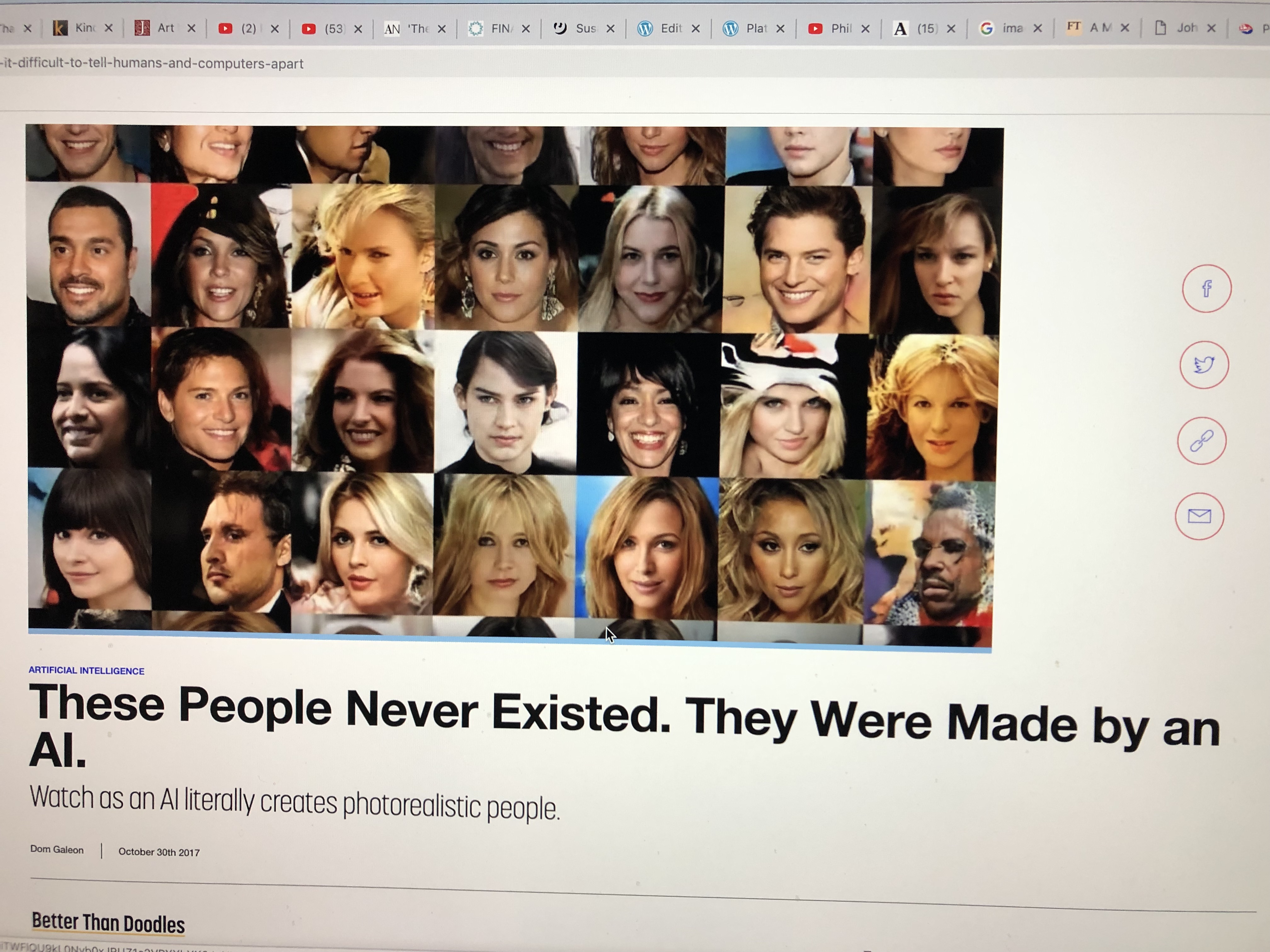
AI, Humanoids and Robots that could be seen as a threat or advantage to our own daily lives, our ideas about human intelligence and conscience, furthermore so due to achievements in other technological fields — such as more efficient processors and memory, rapidly-increasing volumes of available data and continuously improving algorithms — which are enabling further development at completely new levels. These deep learning are improving to next generation machine-learnings which include self-driving cars and software that can filter malicious content – thus recognising objects, and making decisions accordingly. We look at certain jobs that could be replaced by AI: a chatbot that handles business related inquiries on the phone or via the internet; mobile apps which can do translating from almost any language, do facial recognition, run smart home applications, and automated assistants such as Siri and Alexa, robotised restaurants, medical equipment such a scanners, robotic surgery, assisting walking/movement/talk and production plants, advancement in design technology – CAD drawing, 3D printing, etc. A very interesting find I made in these readings on the topic is the application, Articoolo, where the technology is aimed at helping writers create textual content by making the creation process quicker, cost efficient, and much more pleasant. It creates unique content from scratch, simulating a human writer. You choose the topic and length, and our algorithm will create your textual content.
I do think it is important to stand a moment with Plato and his division of good and bad copies – when “selecting among the pretenders’ (Deleuze 1990, 266). In the simplest form one could say an algorithm uses associations and similarities to learn from big data. In facial recognition the way the computer learns ( machine learning) to recognise a face, is by being shown many faces as well as ‘not faces’ – thus that which deviates from the norm will not be recognised as. VR and AR applications are becoming increasingly sophisticated and are increasingly being adopted in the entertainment and well as industry – these are solutions which allow humans to explore fully immersive computer-generated worlds (in VR) and overlay computer graphics onto our view of of our immediate environment (AR). AI technology thus allows computers to understand what they are ‘seeing’ through cameras, this is AR, objects in the user’s field of vision can be identified and labeled. A application can be used to e.g. overlay bunny ears on selfies for Instagram filters.
In Weapons of Math Destruction, a book written by Cathy O’Neil, this data scientist writes about the rising impact of algorithms and makes and appeal for ethical coding practises that are diverse, not creating biases and are accountable in the process. I listened her at a Ted Talk event (Sept 2017) – and her words, “algorithms are opinions embedded in code” made a strong impact. We should learn from this that the human factor needs to stay important. We should not put blind faith in big data. The human is in charge and should be kept accountable and at best this should be open source and not opaque as much of these are. I relate and refer to a part in the Matrix movie where ‘what is real’ is discussed and he is shown the matrix. (pttphs://youtu.be/WnEYHQ9dscY) The character is told his appearance is a ‘residual self image”, a “mental projection your digital self ” He understands that what he feels is simply electrical signals, that everything is a simulation, and that he has been living in a dream world and is then shown the real world — out there, a wild and scary looking place – referred to as the desert of the real.
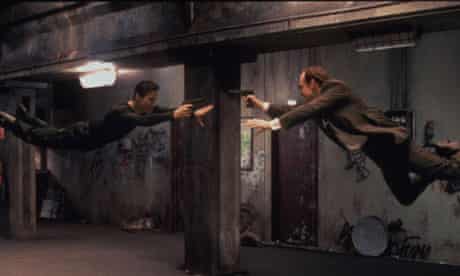
With regards to the film, The Matrix, which saw years ago (when it was released) and the confusion it brought about and discussions we had back then about something out there who will be trying to control us. When reading Deleuze I looked at simulacrum differently, than whilst reading Baudrillard – I found Baudrillard too apocalyptic and scenario and ideology orientated – a type of scare for technological and industrial advancement. I maintain that it stays in the hands of the developers and control has to be accounted for. I do understand that Virtual Reality is simulacra, but this can relate to something real as well as these ideas of Baudrillard about sci fi, science fiction. I recently read that Baudrillard was not interested to collaborate on the sequels of The Matrix and later protested wryly that The Matrix had got him wrong: “The most embarrassing part of the film is that the new problem posed by simulation is confused with its classical, Platonic treatment … The Matrix is surely the kind of film about the matrix that the matrix would have been able to produce.” (The Guardian 2007, Obituary to Baudrillard) I would like to think what he means by that is
With regards to the term, ‘uncanny valley’ Wikipedia describes it as follows: “In aesthetics, the uncanny valley is a hypothesized relationship between the degree of an object’s resemblance to a human being and the emotional response to such an object. The concept of the uncanny valley suggests humanoid objects which appear almost, but not exactly, like real human beings elicit uncanny, or strangely familiar, feelings of eeriness and revulsion in observers. Valley denotes a dip in the human observer’s affinity for the replica, a relation that otherwise increases with the replica’s human likeness““.”
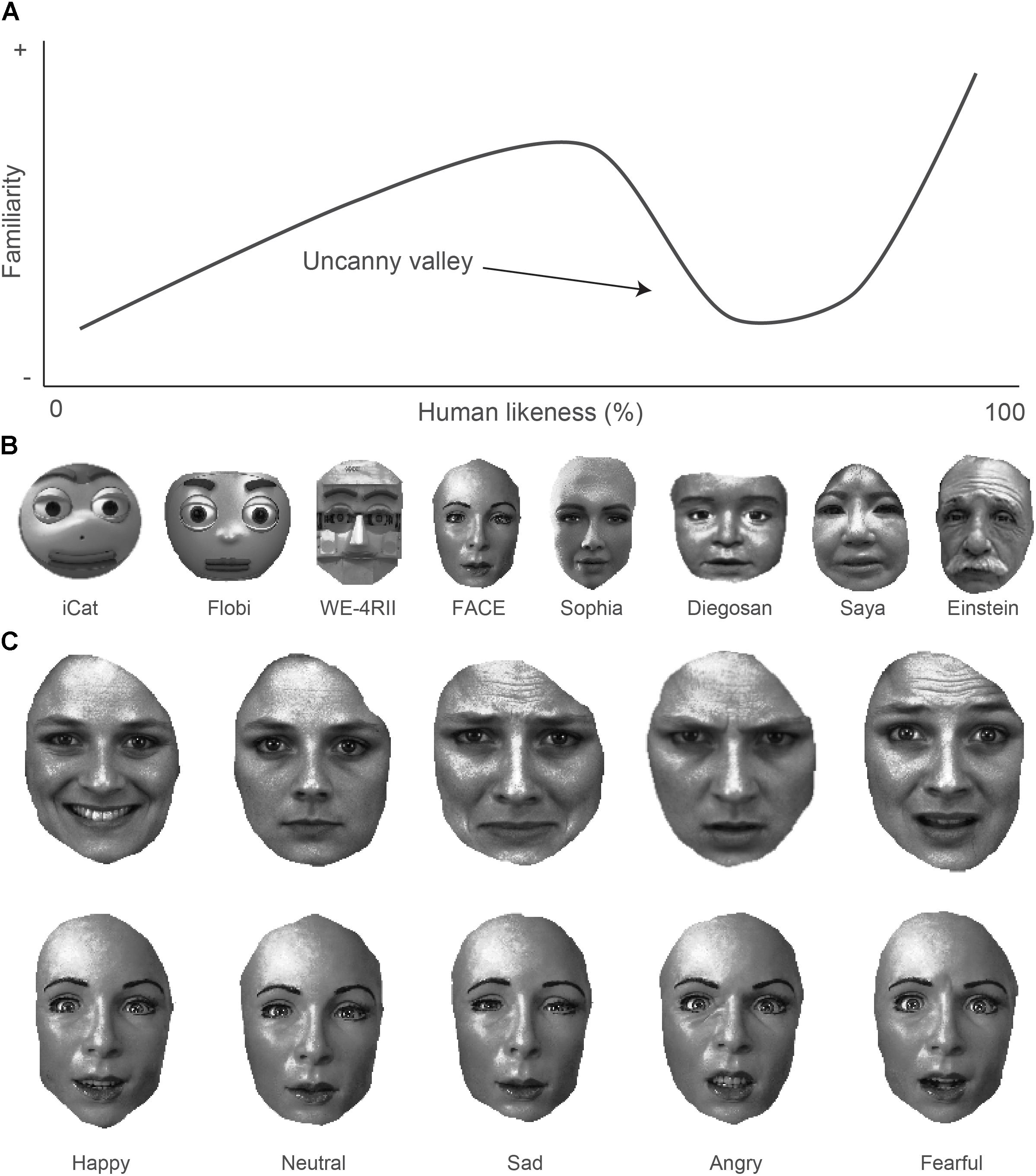
An other research topic that is interesting to pursue scientifically is the role of social intelligence, such as theory of mind (Krach et al., 2008), or automatic and unconscious perception-action coupling, such as imitation (Oztop et al., 2005; Press et al., 2005; Sciutti et al., 2012; Hofree et al., 2015) in the context of negative (Naber et al., 2013c, 2016) and more realistic situations (Mower et al., 2007; Mohammad and Nishida, 2010).
In a recent discussion in our local newspaper, Gulfnews (2019:10) a social media debate on the fear the effects of AI could have on our ‘world’ we discussed. The general feedback was that most social users viewed artificial intelligence as a positive advancement in technology and many highlighted the different ways in which it will impact the world. Reference was made to a 2018 film, called Extinction, where the human fear that robots have taken over the world is played out.
Robots can assist us in our daily living and threaten certain jobs in this process. Advancement of technology is great to connect people, but many fears are around the fact that this same technology can be used against people, my example is use of the application, WhatsApp which connects, but government/institutions can repress it and isolate people. AI can do amazing categorising- but in this can just as well threaten our individuality – it already knows so much about us and our behaviour patterns (find out someone is gay/ smuggler/ vulnerable to buy more) At this level I am thinking about using AI for the benefit or detriment, but it is controlled by humans. There is also the thinking where AI could be limitless, trusted and make decisions without human control being exercised – I think quantum computers and advanced coding, which is not binary can be the change agents here.
Rushkoff David, 2019, Team Human
Rethinking the Value Chain, KPMG study (PDF) A study on AI, humanoids and robots – Artificial Intelligence: Possible business application and development scenarios to 2040. Available from:https://www.researchgate.net/publication/327622476 [accessed Jan 18 2019
Dan Torello, 2015 Congress Library (Kluge centre) article by Dan Torello who had a discussion with John Searle in March 2015. Downloaded form their website.
Searle, JR, 2012, Prospects for a New Realism, a lecture by the philosopher John R. Searle (Department of Philosophy, University of California at Berkeley) at the University of Bonn, Germany. Recorded on March 26, 2012. Online at Uni-Bonn.tv
Falah Gulzar, Gulfnews, Friday 18 January, 2019: Robots in, humans out?
Exercise 3.6 Misrepresentations
Reflect on this last sentence in as many words as necessary to form your own judgement. One cannot say the world is socially constructed and say there are misrepresentations.
In thinking about reality questions as WHY (Idea) and HOW (reason) seems the ones intriguing us most. I also think that socially constructed reality lies within the philosophic domain of knowledge, reason and opinion, but that context is just as important.
Platonism understood the world by division of idea ( the real) from image (copy), original from copy; intelligible from sensible and model from simulacrum – when dealing with this world of appearances of things. So this implies that in this traditional way of looking, images are seen as second order, copies. Deleuze says that simulacra actually proves that not all images are copies. (1990,266- 267) I quote the following from another source, as there was this interesting reference to “chained in the depths” in this version. “We can thus better define the whole of the Platonic motive – it is a matter of choosing claimants, of distinguishing the good from the false copies, or even more, the always well founded copies from the simulacra, ever corrupted by dissemblance. It is a question of insuring the triumph of the copies over the simulacra, of repressing the simulacra, of keeping them chained in the depths, of preventing them from rising to the surface and “insinuating” themselves everywhere. ” (1983, 48)
When we think of misrepresentations it could be something that implies the representation was wrong, intentionally or unintentionally. Here comes , context, which we need. With simulacrum, instead of true reality, we get various types of simulacra, which presents themselves as real. We can find ourselves more and more in a society/culture where meaning has become destabilised through, for example, mass media. We are seeing signs of misplacing or displacing of the real. So our world/reality is replaced its a ‘take-over’ of reality by the sign, which appear to be the thing, or it simulates the thing, or it copies the thing or it imitates to be the thing, or it resembles the thing, or it pretends to be the thing. I go back to poetry of Walt Whitman or essays of Emerson I am being reminded of a longing for nature…..as if a state of good, true, and real, compared to the city life and disconnect from nature and or God.
Modernity, seems to me, has a paradoxical character – when we look at ideality and reality in modernity. Here real becomes hyperreal, representation becomes interpretation, substance becomes form, objects become images and rationalism is becoming symbolism. Baudrillard says reality is experienced differently depending on who and where are at any given moment as well as your information, etc. If we look at the media, everything represented is experienced as multiple realities, all of which – and none of which – are authentically real; everything is simply a representation of something seen from different viewpoints, which could easily be misrepresented. The conventional way to look at media representations, therefore, is in terms of how and why they misrepresent particular groups. Baudrillard (1995), argues representations should not be considered in terms of whether something is fairly or unfairly represented because how something is represented is its reality. He refers to Hyperreality to express how different narrative accounts interweave and conflict in an ever-changing pattern of representation-built-upon representation until they form a ‘reality’ in themselves – something “more real than reality”, because our knowledge of ‘reality’ is itself the product of different representations. Each reality, therefore, is constructed from the way individuals pick-and-choose different ideas to suit their own particular prejudices or beliefs. The media becomes the message. Images of hungry children become the covers of magazines I understand that Baudrillard, a French sociologist ( 1929 -2007) was trying to explain how society has brought reality to real – how society simulates real.
In the thinking processes of Plato and further, I understand the idea of using division in thinking about reality, the real continued within this division of either real or false; original or copy. For the artists is was a question of how to represent a picture that is more true or more real to life. Modernity brought the artist to the question of in what way are things being represented – what makes things appear that they are?
I searched the internet for the words – ‘representing other artist’s work’ , not copying them, and found some interesting commentaries:
“As an exercise, you can privately copy an artist just to get a feel for their marks and a sense of how they pull a painting together. Generally, it feels unnatural, although you may discover that you love a certain aspect. From there, work to bring what you learned into your own art in a way that is true to you, rather than as a direct copy. This originality and uniqueness comes from taking whatever it is that inspires you and pushing it until you enter a new realm that’s entirely yours.”
In the readings of Gilles Deleuze (P 263:The Simulacrum and Ancient Philosophy essay) I tried to make sense of Plato’s discourse on images/idols. Deleuze explains that Plato needed to select among the ‘pretenders’, distinguishing the good and bad copies, true and false, that is copies and simulacra, and Plato had to repress the Simulacra, preventing them to manifest or come into being in his search for logic and reason to be the ultimate judge in all philosophical questions and arguments. Plato felt strong about order, as he perceived the current-day Athens during his time – his reality as a kind of anarchy/chaos/open field. He comes from a conservative place. Deleuze therefor thinks the image became entangled in this discourse, which was actually about politics. He sees simulacra as an image, not an idea, which is not making any claims to be true, it is merely trying to be, to be interesting be seductive. He sees the simulacra outside of knowledge and reason. For Plato however the simulacra disturbed the model he was trying to establish and according to Deleuze he therefore had to “repress simulacra’ (1990,266) Social construction is relational and self-referential by nature of language. Meaning is a result of speech (Deleuze). Absolute truth does not exist.
It is important to look at ‘resemblance’ and ‘sophist’ at this stage and not understand resemblance from an external relation. In this case a copy ‘truly resembles something only to the degree that it resembles the Idea of that thing’ (Deleuze: p 266) I understand the ‘Idea” of that thing as something in my mind, where logic operates. Sophists used rhetoric to win arguments, by various rhetorical devices – like the absurd, personal attacks, no distinction and or hierarchy between the image and the real, says it is not relevant, it does not matter. (my example: does it matter if Manet painted the Luncheon on the Grass? Here we have Koons Gazing Ball painting, not claiming to be the truth, but it is even more real) So Sophism does not lay claims to truth, but by faking, bluffing, cheating it wins arguments. It is about winning, not being right!So now we come to art in the contemporary day, the artist is a sophist – by making something, an object, which is an indication that looks like. Contemporary art is just making something that looks like… it just is….a thing, like Duchamp’s Urinal, this is trying to be a thing – it is the same reality, it tries to be the real! Deleuze (P265) states: “The Sophist himself is the being of the simulacrum, the satyr or centaur, the Proteus who meddles and insinuates himself everywhere.” Deleuze feels Simulacra must get its rightful place – in the first passage of his seesa on the Simulacrum (Deleuze p263) he talks about “to reverse Platonism”, other translations says to overthrow Platonism, which is the task of philosophy of the future.
In the introduction of Foucault , I read the following:Foucault’s Deleuze is a “reverse Platonist” (p. 544): he opens the door to all the alleged “imitations” and all the alleged “imitators” that Plato so distrusted. Plato urges the thinker to ascend from the world of transitory “appearance” to a sublime world of eternal and perfect Forms;51 Deleuze urges the thinker to look down. He subverts Plato with his meticulous scrutiny of “a crop of hair or the dirt under its fingernails” (p. 546). He “perverts” Plato in inclining toward “the Sophists’ spitefulness, the unmannerly gestures of the Cynics, the arguments of the Stoics, and the fluttering chimeras of Epicurus.” He makes us want to read that most unmannerly of Cynics, Diogenes Laertes. Deleuze is a philosopher of “all this swarming of the impalpable,” a philosopher of emanations and phantasms that “topologize the materiality of the body.” He escapes “the dilemmas of truth and falsehood and of being and nonbeing,” and lets his phantasms “conduct their dance … act out their mime, as ‘extrabeings'” (pp. 546-547). Deleuze teaches us how to think about the “pure event,” and about the relation between the pure event and the phantasm. The former has no extension, either in space or in time; the latter is the event “in play,” contracted or expanded to fit the scale, the pace, and the import of the story of which it is part.
I looked at Plato’s concerns with agricultural sculpturing – huge statues and sculptures that are on eye level are very distorted (ugly), but from afar it looked perfect – but the basis of design was logic – but it used ‘pretension’ / illusion to let the viewer see it as not distorted. Camille explains the conversation in Plato’s Sophist and how to distinguish between the real and the copy – what is the test? It seems we have to look at division – Delueze states Ultimate question is who you will take as your teacher, the sophist or Socrates? As an artist, we have the choice what or who one wants to be in this practice of representation. I also think we are more open to see where art enchants as well as deceives, because the artist, like any other human being, is, as Sartre claimed, condemned to freedom.
I am also aware of our tendency to rely on semiotics to give us the truth – should think about the distinction between the signals and signs – signifiers (image or mental impression) and the signified (thing/ content-form) the message, which will be addressed in later exercises. Deleuze states that a signal is “a structure. “Language is a form and not a substance” (Saussure 1950: 122). To the perceptible and measurable signals Saussure ascribed a signifier or an expression-form, which is understood as an image (mental impression) of a signal (Saussure 1950: 122–123) or as a set of signals . To the message content actualized in the interpreter of the signals they assigned a signified (Saussure) or a content-form (Hjelmslev), which is understood as an image of a message (Saussure 1950: 66–67) or as a set of such messages. Belgian artist René Magritte has written below an image of a pipe “This is not a pipe” in French. One answer is that it is a painting of a pipe, and that a painting of a pipe is not a pipe, but only a way of representing a pipe. The same could be said of the word “pipe.” The word “pipe” is not a pipe either, but only a word that has the power to stand for the presence (or absence) of a pipe. Magritte’s picture hights the gaps between language and meanings, thus raises questions about the ability of images and language to represent or misrepresent the world itself.
I am thinking about having a reason for being – a necessity for existing – it this what we are looking for. I can push it further – a work of art can leave a legacy, which can be seen as proof for being here on earth at a given time. Does it all boil down to our own demise, death, which is inevitable?
It is no more essential to the understanding of a proposition that one should imagine anything in connexion with it, than that one should make a sketch from it.
Wittgenstein, Philosophical Investigations
Deleuze Gilles,1990 Logic of Sense, Bloomsbury Academic Publishing Plc, London UK
Deleuze G & Krauss R, 1983 Plato and the Simulacrum JSTOR, Oct, Vo l27, pp 45 -56, Published by MIT Press, accessed 07/02/2019
Foucault Michel, Aesthetics, Method and Epistemology, Essential Works of Foucault, 1954 -1984 Volume Two. Downloaded online from Monoskop.org website.
Oxford University Press, “Art in the 21st century,” in Smart history, August 9, 2015, accessed January 7, 2019, https://smarthistory.org/art-in-the-21st-century/.
Sontag Susan, 1977 On Photography, Kindle edition
Exercise 3.7 Write a paragraph on a single work by Koons according to what you understand of the simulacrum. (400 words)
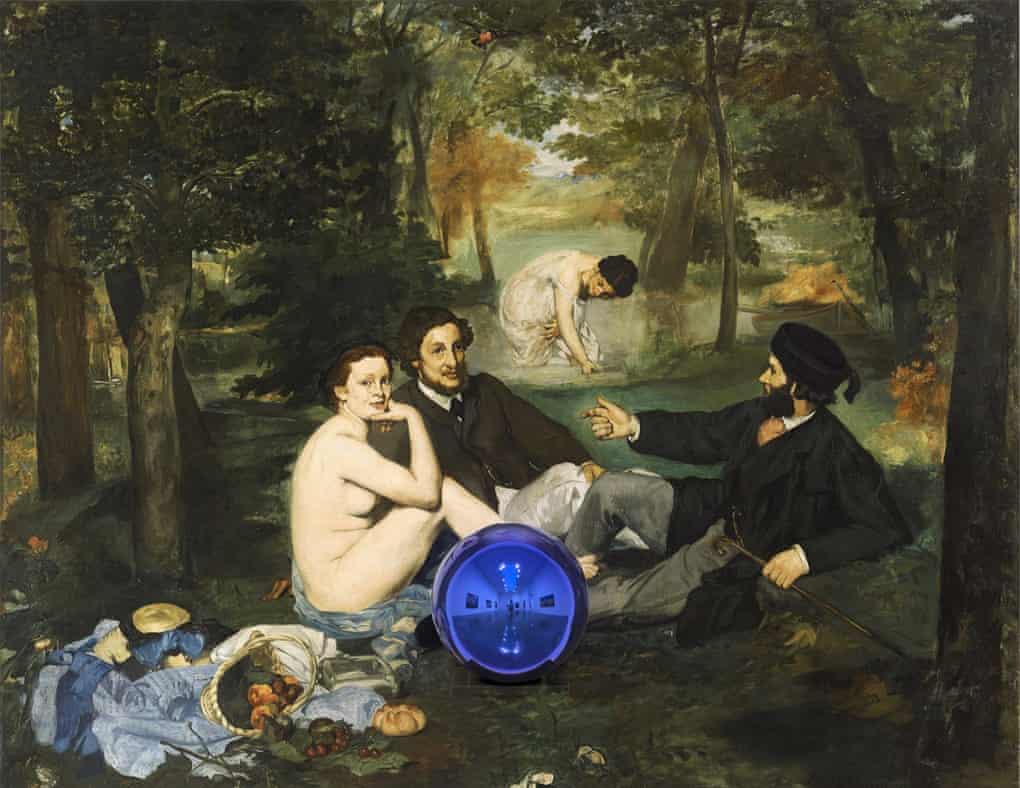
Gazing Ball above is part of a huge group paintings of copies of the original artworks. This one was originally called Luncheon on the Grass by Manet, 1862. Jeff Koons appropriates from Art History; Baudrillard sees in Pop Culture the replacement of reality. These works present repainted versions of masterpieces, with a shiny blue sphere placed in front of each. Koons said that the images he’d used were not intended to represent the canon but instead were works that he enjoys … “my cultural DNA”. He pointed to artists referring one another – “Monet is always referencing Rubens … Manet is referencing Raphael … everybody enjoyed Titian.” By saying this Koons could indicate simulacra – as there is no ‘unique’ or ‘original’ in simulacra – is he challenging the original copy paradigm? Could it be seen in the same way as Levine’s idea with After Walker Evans and putting in the question what does true or real means? Koons describe the work as follows: “The images are all handmade paintings, every mark on here has been applied by a brush. These are as exact replicas visually as the originals, they’re different in size, they’re flat, they don’t have dimensional paint” – in other words, a raised surface – “because they’re just the idea of the painting. This is just the idea of the Mona Lisa, the idea of Leonardo da Vinci, this is the idea of Marcel Duchamp’s LHOOQ, this is the idea of Andy. ”
I think about the simulacrum as an image without resemblance, and consider that Greenberg would identify this work with Kitsch. The works are produced by different means than when an artists makes a copy of the original painting – this is reversed into the simulacrum. Koons does not want his viewer to percieve the work being about a copy, he states this is about “this union, the concept of participating – the act of looking and the relationship between the pictures. Everybody in this dialogue of sharing enjoyment and pleasure.” (Financial Times, 7 December, 2018) Koons hereby shifts the viewers focus away from what is being represented towards how the image is represented and produced – his artistic intention and context becomes more important in his work. Baudrillard would thus state what we are at the point of hyperreality, because our knowledge and understanding of the world is now primarily derived through signs that have come to replace reality. The ‘sovereign difference’ between the real and the simulacrum is now lost: it is no longer a matter either of an original real and a representation, there is no relationship between them at all.
In another online article in ArtNews.com: “Everybody’s in this dialogue of connecting with each other. The objective world is the acceptance of others. It’s the removal of judgment. It’s enjoying people. It’s enjoying your community, and that’s the dialogue that’s taking place……These paintings are stronger being together with the gazing ball. If you take away the gazing ball, they don’t have the same power. They don’t have the same phenomenology taking place. These paintings are masterpieces in their own time, but in this time, this moment, they’re most powerful in this state, with this gazing ball.” (2011) Pure simulacrum according to Baudrillard – a he undermines the distinction between a copy and the real (Massumi) and saying this simulacrum is better than the real. The mere representation of the works being more (hyper?) alters our perception of what is real – this is the now in the experience with the artwork – this is the real. Baudrillard calls this a simulacrum. Accordingly the artist hereby hide the fact that there is no true authentic reality, only the simulation of reality, which is the truth, but that which hides the absence of truth. Baudrillard identifies this as art ’s reliance on what he terms the ‘reality principle’, which is where art becomes an effect of its disappearance. He explained this phenomenon using the allegory of Disneyland to capture the ironies of this postmodern situation. Oscar Capezio discuss the ‘transcendental simulacro’ of Jeff Koons and the understanding of the changing relationship between ‘representation ‘ and ‘reality’ in a postmodern era characterised by simulation and virtuality.
The blue spheres were hand-blown – Koons commissioned 350 and picked the best 35. “Each one’s unique,” is his comment. By standing in front of these paintings the viewer sees him- or herself reflected in the gazing ball. Koons wants the viewer to have a personal experience – “your desires, your interests, your participation, your relationship with this image” is what he explains. I would describe these balls as referring to American Consumer Culture as well as a reference to the materialistic Aristotelian view of the world with fascination of optical devices like mirrors, in order that the artist show images as phantasmic alternatives, compared to a mere copy.
Deleuse states that modernity is defined by the power of the simulacrum – the artificial in these works pushed through the point that it is reversed into the simulacrum. I do think the high prices this artists work receive in the art market is also something that I can relate to the Hyperreal Baudrillard refers to. Koons works have established a brand and in the hierarchy of art prices they are in the highest level of a living artist. I think this would be seen as ‘sign-value’ by Baudrillard.
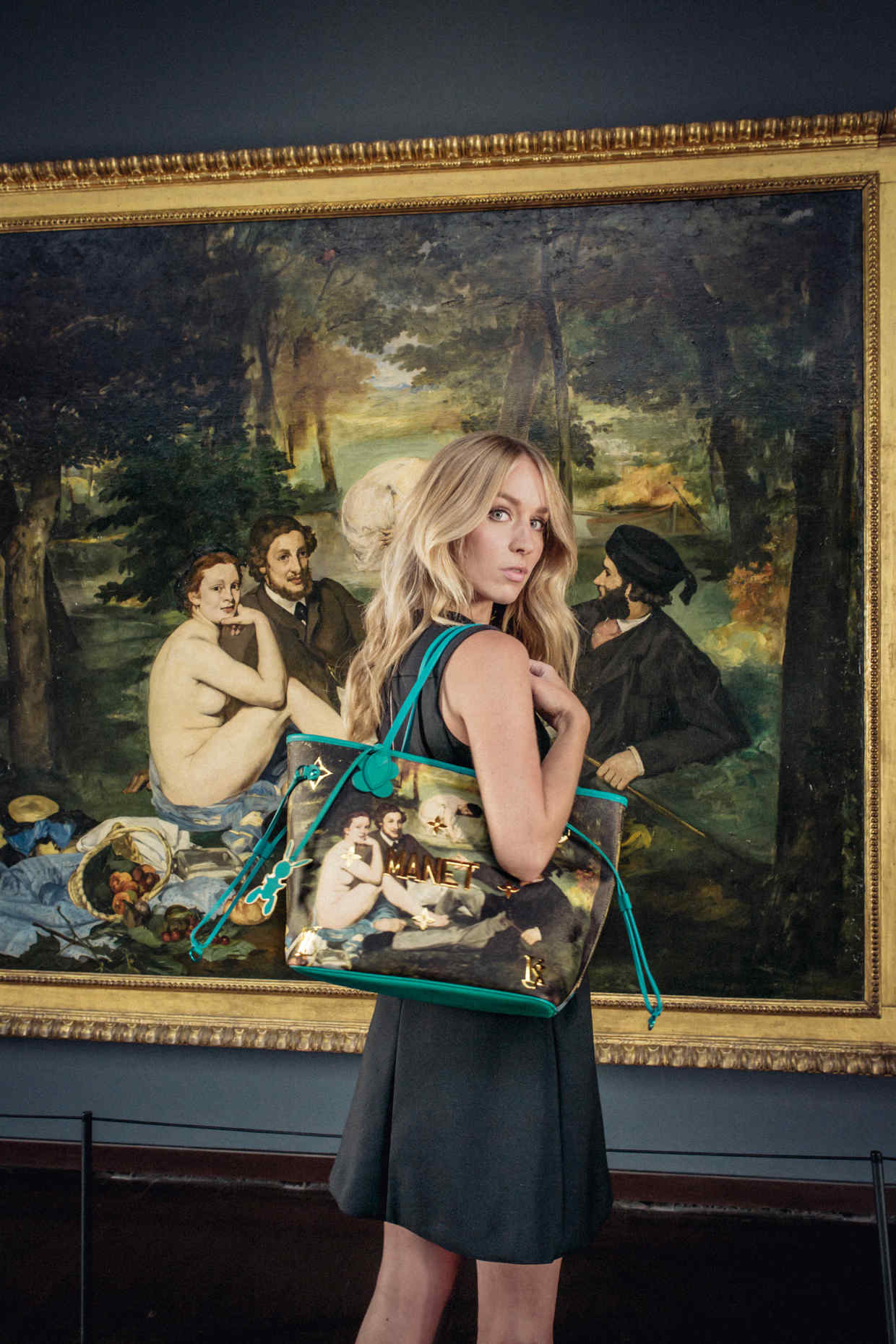
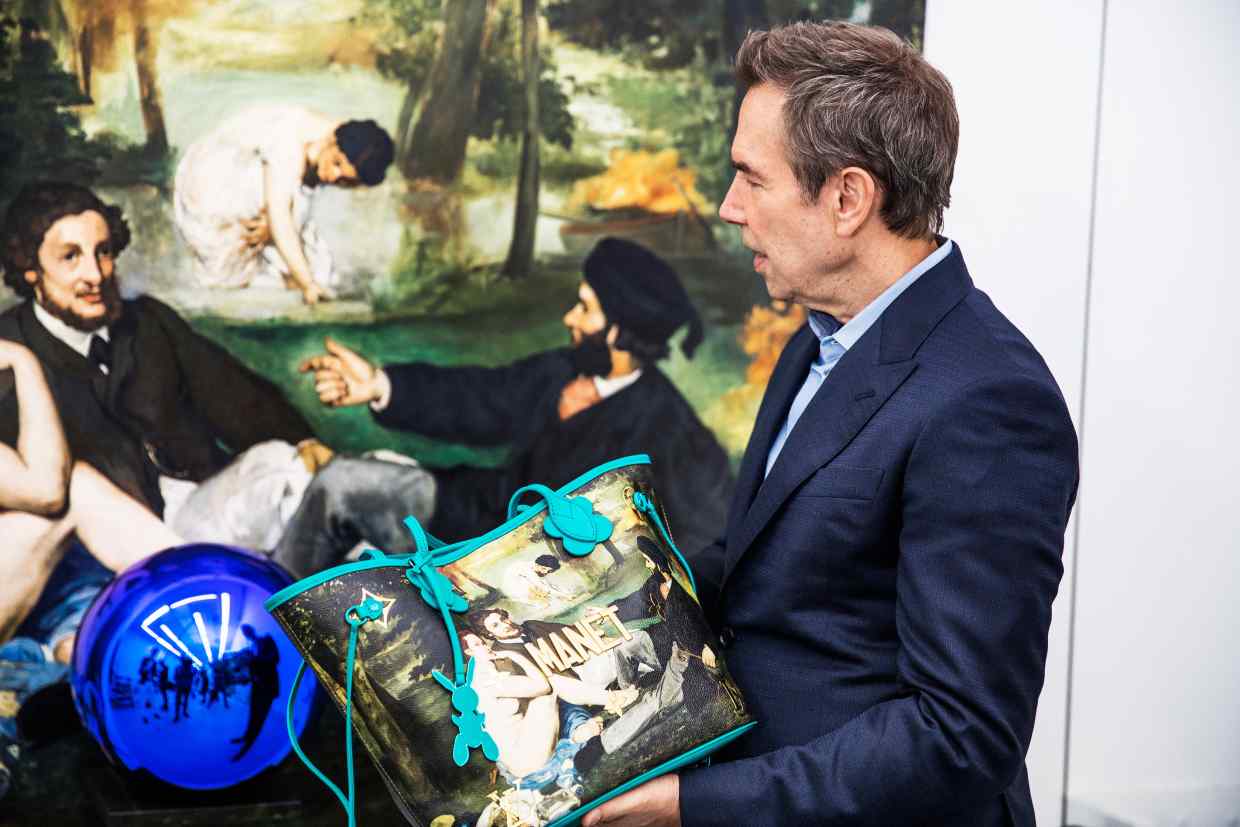
And that’s what I’ve done here. That’s what I try to at least practice. But I really wanted to contribute to the dialogue—the metaphysical dialogue about objective and subjective.” He said he wanted to make something that was both “Duchampian” and “quite intellectual.”
“And at the same time,” Koons said, “so much of the freedom I have as an artist really comes from intuitive thought and the subjective place of following my own emotions. My own response to things. So with this series, I really wanted to have the dialogue—the dialogue of humanity. Really, kind of the DNA of, at least, my cultural experience. This is not the canon of art history, but these are works that I enjoy. They’re my cultural DNA. But what’s so beautiful is that the way art functions is similar to our genes. It parallels that. All these different connections, it’s like a double helix. And it parallels the inorganic with the organic. Everybody here is referencing each other.” and further at Mona Liza painting: “We walked over to a canvas depicting the Mona Lisa, once again with a blue gazing ball in front of it. “Everything that we’re looking at,” Koons said, “these are all handmade paintings. Everything has been painted by hand. There is nothing printed. Every mark on here has been applied by a brush. These are as exact as the originals. Replicas.” He added, however, that they differed in size from the originals. “They’re just the idea of the painting. This is just the idea of the Mona Lisa. This is the idea of Leonardo da Vinci.” The work, he said, was also the idea of Duchamp and the idea of Warhol. “It’s not about being a copy. It’s not art that’s about copies. This is about this union of being together, this dialogue. It’s the concept of the avant-garde, of being together in a group and participating……These paintings are stronger being together with the gazing ball,” he said. “If you take away the gazing ball, they don’t have the same power. They don’t have the same phenomenology taking place. These paintings are masterpieces in their own time, but in this time, this moment, they’re most powerful in this state, with this gazing ball.”
I have by now read the Deleuze essay, The simulacrum and ancient philosophy, and would like to refer to (1990,269) where he states that “Aesthetics suffers from a wrenching duality…….the essential characteristic of the modern work of art. It is not at all a question of different points of view on one story supposedly the same; for points of view would still be submitted to a rule of convergence. It is rather a question of different and divergent stories, as if an absolutely distinct landscape corresponded to each point of view” Deleuze almost challenges quantum physics in stating there is not only one reality of which there are several images, he says there are only different images, and in a sense it is the different narratives of these images that constitutes reality – it is all there is.”
Bibliography
Aspen, Peter, 2018, FInancial Times , Jeff Koons: I don’t believe in perfection, downloaded from www.ft.com on 20 January 2019.
Baudrillard Jean, 1994, Simulacra and Simulation. University of Michigan Press, USA
Capezio, Oscar 2012, Hyperreality in the Post-Modern Age: Kitch and Porno kitch, Academia.edu file downloaded 0n 20 January 2019
Deleuze G, 1990, Logic of Sense, Bloomsbury, London
Massumi Brian, 1987, Realer than Real: The Simulacrum According to Deleuze and Guattari , pp 90 -97
Miller,H M 2011, Art News.com online article 11/09/05
Miller, H M 2015, Art News online article , These are works that I enjoy: Jeff Koons on his amazing blue balls.
Pietz William, 2003 Fetish, The Art of Art History 2009 edition.
Online videos on Youtube: BBC, Larry Gagosian and Jeff Koons, Jeff Koons and Heidi Zuckerman
Schneider Tim, 2019, ArtNet News, Who needs Assistants when you have Robots?
My own reflection on this exercise:
Reflecting on this exercise is really what I needed by now! I am left with more questions as when I started out with this exercise. My reaction that it also gives the viewer an opportunity to reflect on his/her relationship to the real is strong – I know this is a copy of a masterpiece, of which not many people have seen the ‘real artwork’ and might not even care, only the ‘informed knows it’ as a copy. I do think the work veers between objects and concepts, and between reality and representation. This is a statement made by the artist, which he has become famous for: “The job of the artist is to make a gesture and really show people what their potential is. It’s not about the object, and it’s not about the image; it’s about the viewer. That’s where the art happens.” At this point I am very aware of my reading Susan Sontag, On Photography, the essay, America, seen through Photographs, Darkly (kindle version) She refers to Walt Whitman where “no moment is more important than any other moment; no person is more interesting than any other person”, further on..”..the artist as a heroic, romantic, self-expressing ego”. Koons wants his works to be ‘transcendent’ and he plays on this ‘American Dream’ in which Whitman also believed. I find this a difficult message of identification, and tend to go to the side of Deleuze and his “aesthetic proposition which suffers from duality” and later he describes this as “the characteristics of the simulacrum”, when it “breaks its chains and rises to the surface: it then affirms its phantasmatic power, that is, its preseed power” ………”Thus the conditions of real experience and the structures of the work of art are reunited: divergence of series, decentering of circles, constitution of chaos”…..”Such system, constituted by placing disparate elements or heterogeneous series in communication, are in a sense quite common. They are signal-sign systems.” (1990, 270)
I am also contemplating the following: Is Koons saying that the works of the Old Masters are readymades? According to the ModernMet (website) in their interpretation of the original Manet picture, which hangs in Paris’ Musée d’Orsay’, ” Le déjeuner sur l’herbe—testimony to Manet’s refusal to conform to convention and his initiation of a new freedom from traditional subjects and modes of representation—can perhaps be considered as the departure point for modern art.” They indicate to his reference to a picture Italian inspired by two 16th-century Italian works of art: The Pastoral Concert and The Judgment of Paris , works by Titian and or Giorgioni, 1509. Koons admired the work of Duchamp and Duchamp refused to conform to convention of what art is, in his day.
I also think Koons work has pushed art as a consumable object – the ‘ old history of art’ is more familiar by these works locked somewhere in a museum, High and low art is not so distinct. I do think his work ethic/practice is very conscious with the ‘perfection’ of his medium – as he (producer) understands ‘high culture’ (user) and their fetish on appearance – Can I read this into the care taken to present his technically difficult, expensive to produce, yet beautifully made objects where execution seems obsessively faultless and in a way a hyper aesthetic appeal and heightened experience brings the viewer into contact with the art? (the artist remarked with regards to ‘anxiety’ – “if you make no judgements and see them (the works) as tools of therapy, they will reward you with self-knowledge and contentment”) The Enlightenment theory of fetishism (Pietz 2003: p110) comes to mind. I think that the simulacrum is also in the price the market offers for his works – people abstracted aesthetic value into the joy of acquiring – something about signs or signifiers of luxury and austerity. Baudrillard, talks about the ‘commodity’ to the society of the ‘spectacle’- a new dematerialized society of signs, images and codes. I found the following quote in another article where the discussion veered to the high prices his works fetch: ” I try to educate people about materialism through my work. I try to show them real visual luxury. It’s intoxicating visually.” (The Guardian, 2015, an interview with Emma Brocks and Jeff Koons) It reminds me of Susan Sontag where refers to the adjectives – “the childlike wonder of the pop mentality” in her book, On Photography. Oscar Wilde’s statement rings in my ears:” Life imitates art far more than art imitates life. In this deconstruction of art, imitation provides us a place to escape our own existential crisis, therefore life must imitate art because there is nothing true, other than our feelings expressed.
Whilst doing this exercise and reading about the artist, I remembered and earlier exercise, page 30, Exercise 1.3: “In what sense could 1. a Dyson vacuum cleaner…… be works of art. Take a speculative approach to this question. Don’t’ say whether you think they are, or should be, considered as art. Rather say how someone might see them that way” When artists challenged assumptions about art, did it become necessary to say what art is – and like reality, institutional theory do not know! My tutor reminded me in the formative feedback to keep ‘context’ in mind and implying to the fact that virtually any object when placed in an art gallery will be approached with a particular mind-set. We will expect it to be art, and try to interpret is as such. I recently came to hear of a study that came to some form of a conclusion when people are told something is art, that there brains then search for confirmation and accepts it as so.
Koons insists the monetary value attached to his art is just an “abstraction” to him….. I’m flattered that my works are perceived by society as having some relevant value. But the beauty to have impact with real individuals, that they can come across their own potential, that’s what really brings me joy,” ( Hong Kong AFP, 2018) I recall reading about Andy Warhol starting out as a commercial artist, going so far as to say, making money is art. It was interesting to find so many of the articles and videos on Jeff Koons did move to referring to his earlier work as a salesman who exceeded in understanding his customer. Both these artists are very connected to the rich and famous, powerful (plutocrats?) I would have loved to view the HBO Documentary Film, The Price of Everything (2018), but could not find a way to view it as to date. ( Will have an opportunity at end of March, at a local art theatre, and will write about it in my study log.) To his critics his work is overrated, overpriced and obvious. To his fans, he is a living legend — the incarnation of the Pop Art movement Koons set an auction record for the highest price paid for any work by a living artist in 2013 when his orange “Balloon Dog” fetched US$58.4 million at Christie’s in New York. At the other end of the spectrum, art is synonymous with money, as those at the top echelons of the art market – the 0.1 per cent of the art world – value their sales in the tens of millions. Banks drive an art lending business. Art is collateral in this society. In 2016 the US outstanding loans in this business was estimated at between $15 – $19 Billion – the market sees the speculative value in art . The hallmark of consumer culture is the creation of products and services which have both use value and exchange value. Marketing practice is based on the knowledge that helps achieve its main goal of creating marketable products – art surely fit into this. Since modernity represents the rise of capitalism which legitimates the exploitation of both nature and culture for the pursuit of wealth accumulation, marketing becomes the consummate instrument in creating the ethos of consumption with which we are all identified. (I read an article 2005 published online by Douglas Keller on the Art Conspiracy publication of Baudrillard of 1996 – this has surely influenced the additional reflection above)
